上海交通大学:《生物化学 Biochemistry(B类)》课程教学资源(题库与答案)Chapter 9 Catalytic Strategies
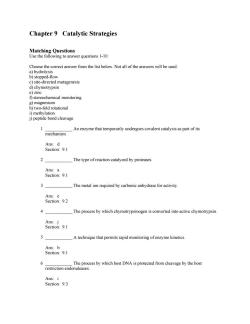
Chapter 9 Catalytic Strategies Matching Questions Use the following to answer questions 1-10: Choose the correct answer from the list below.Not all of the answers will be used. a)hydrolysis b)stopped-flow c)site-directed mutagenesis d)chymotrypsin e)zinc f)stereochemical monitoring g)magnesium h)two-fold rotational i)methylation j)peptide bond cleavage 1 An enzyme that temporarily undergoes covalent catalysis as part of its mechanism Ans:d Section:9.1 2 The type of reaction catalyzed by proteases Ans:a Section:9.1 3 The metal ion required by carbonic anhydrase for activity. Ans:e Section:9.2 4 The process by which chymotrypsinogen is converted into active chymotrypsin Ans:j Section:9.1 5 A technique that permits rapid monitoring of enzyme kinetics. Ans:b Section:9.1 6 The process by which host DNA is protected from cleavage by the host restriction endonuleases. Ans:i Section:9.3
Chapter 9 Catalytic Strategies Matching Questions Use the following to answer questions 1-10: Choose the correct answer from the list below. Not all of the answers will be used. a) hydrolysis b) stopped-flow c) site-directed mutagenesis d) chymotrypsin e) zinc f) stereochemical monitoring g) magnesium h) two-fold rotational i) methylation j) peptide bond cleavage 1 ____________ An enzyme that temporarily undergoes covalent catalysis as part of its mechanism. Ans: d Section: 9.1 2 ____________ The type of reaction catalyzed by proteases. Ans: a Section: 9.1 3 ____________ The metal ion required by carbonic anhydrase for activity. Ans: e Section: 9.2 4 ____________ The process by which chymotrypsinogen is converted into active chymotrypsin. Ans: j Section: 9.1 5 ____________ A technique that permits rapid monitoring of enzyme kinetics. Ans: b Section: 9.1 6 ____________ The process by which host DNA is protected from cleavage by the host restriction endonuleases. Ans: i Section: 9.3
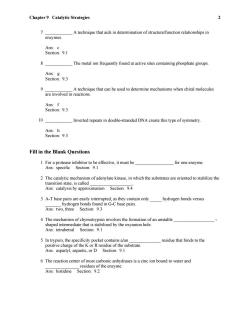
Chapter 9 Catalytic Strategies 2 7 A technique that aids in determination of structure/function relationships in enzymes. Ans:c Section:9.1 8 The metal ion frequently found at active sites containing phosphate groups. Ans:g Section:9.3 9 A technique that can be used to determine mechanisms when chiral molecules are involved in reactions. Ans:f Section:9.3 10 Inverted repeats in double-stranded DNA create this type of symmetry. Ans:h Section:9.3 Fill in the Blank Questions 1 For a protease inhibitor to be effective,it must be for one enzyme. Ans:specific Section:9.1 2 The catalytic mechanism of adenylate kinase,in which the substrates are oriented to stabilize the transition state,is called Ans:catalysis by approximation Section:9.4 3 A-T base pairs are easily interrupted,as they contain only hydrogen bonds versus hydrogen bonds found in G-C base pairs. Ans:two,three Section:9.3 4 The mechanism of chymotrypsin involves the formation of an unstable shaped intermediate that is stabilized by the oxyanion hole. Ans:tetrahetral Section:9.1 5 In trypsin,the specificity pocket contains a/an residue that binds to the positive charge of the K or R residue of the substrate. Ans:aspartyl,aspartic,or D Section:9.1 6 The reaction center of most carbonic anhydrases is a zinc ion bound to water and residues of the enzyme. Ans:histidine Section:9.2
Chapter 9 Catalytic Strategies 2 7 ____________ A technique that aids in determination of structure/function relationships in enzymes. Ans: c Section: 9.1 8 ____________ The metal ion frequently found at active sites containing phosphate groups. Ans: g Section: 9.3 9 ____________ A technique that can be used to determine mechanisms when chiral molecules are involved in reactions. Ans: f Section: 9.3 10 ____________ Inverted repeats in double-stranded DNA create this type of symmetry. Ans: h Section: 9.3 Fill in the Blank Questions 1 For a protease inhibitor to be effective, it must be _________________ for one enzyme. Ans: specific Section: 9.1 2 The catalytic mechanism of adenylate kinase, in which the substrates are oriented to stabilize the transition state, is called ___________________. Ans: catalysis by approximation Section: 9.4 3 A-T base pairs are easily interrupted, as they contain only _____ hydrogen bonds versus _______ hydrogen bonds found in G-C base pairs. Ans: two, three Section: 9.3 4 The mechanism of chymotrypsin involves the formation of an unstable __________________ - shaped intermediate that is stabilized by the oxyanion hole. Ans: tetrahetral Section: 9.1 5 In trypsin, the specificity pocket contains a/an ______________ residue that binds to the positive charge of the K or R residue of the substrate. Ans: aspartyl, aspartic, or D Section: 9.1 6 The reaction center of most carbonic anhydrases is a zinc ion bound to water and _______________ residues of the enzyme. Ans: histidine Section: 9.2

Chapter 9 Catalytic Strategies 3 7 In chymotrypsin,the tetrahedral intermediate transition state is stabilized by a structural feature referred to as the“ ”hole. Ans:oxyanion Section:9.2 8 In proteases such as papain,a residue is activated by hydrogen-bonding to a histidine residue. Ans:cysteine Section:9.1 9 Enzymes that transfer a phosphoryl group from NTP to NMP are referred to as Ans:nucleoside monophosphate kinases Section:9.4 10 A characteristic feature of NMP kinases is a sequence of Gly-X-X-X-X-Gly-Lys that is referred to as the Ans:P-loop Section:9.4 Multiple Choice Questions 1 Which amino acids in chymotrypsin are found in the active site and are participants in substrate cleavage? A)his,ser,asp B)his,ser C)asp,lys D)lys,arg E)his,ser,arg Ans:A Section:9.1 2 How is specificity determined by chymotrypsin? A) interaction of the active site amino acids with the substrate B) binding of the N-terminus amino acid at the active site C) covalent binding of a his residue to the substrate D) conformational change upon binding of substrate E) binding of the proper amino acid into a deep pocket on the enzyme Ans:E Section:9.1 3 Where does cleavage of the scissile bond by chymotrypsin occur? A) between a his and ser amino acid B)on the N-terminal side of a phe or trp residue C)on the C-terminal side of a phe or trp residue D) at the N-terminal amino acid E) on the C-terminal side of an arg or lys amino acid Ans:C Section:9.1 4 Which of the following is NOT a way in which enzymes stabilize a transition state? A) causing the temperature of the environment to increase B) covalent catalysis C) using binding energy D) general acid-base catalysis E) catalysis by approximation Ans:A Section:Introduction
Chapter 9 Catalytic Strategies 3 7 In chymotrypsin, the tetrahedral intermediate transition state is stabilized by a structural feature referred to as the “___________________” hole. Ans: oxyanion Section: 9.2 8 In proteases such as papain, a ___________________ residue is activated by hydrogen-bonding to a histidine residue. Ans: cysteine Section: 9.1 9 Enzymes that transfer a phosphoryl group from NTP to NMP are referred to as _______________________. Ans: nucleoside monophosphate kinases Section: 9.4 10 A characteristic feature of NMP kinases is a sequence of Gly-X-X-X-X-Gly-Lys that is referred to as the ______________________. Ans: P-loop Section: 9.4 Multiple Choice Questions 1 Which amino acids in chymotrypsin are found in the active site and are participants in substrate cleavage? A) his, ser, asp B) his, ser C) asp, lys D) lys, arg E) his, ser, arg Ans: A Section: 9.1 2 How is specificity determined by chymotrypsin? A) interaction of the active site amino acids with the substrate B) binding of the N-terminus amino acid at the active site C) covalent binding of a his residue to the substrate D) conformational change upon binding of substrate E) binding of the proper amino acid into a deep pocket on the enzyme Ans: E Section: 9.1 3 Where does cleavage of the scissile bond by chymotrypsin occur? A) between a his and ser amino acid B) on the N-terminal side of a phe or trp residue C) on the C-terminal side of a phe or trp residue D) at the N-terminal amino acid E) on the C-terminal side of an arg or lys amino acid Ans: C Section: 9.1 4 Which of the following is NOT a way in which enzymes stabilize a transition state? A) causing the temperature of the environment to increase B) covalent catalysis C) using binding energy D) general acid-base catalysis E) catalysis by approximation Ans: A Section: Introduction
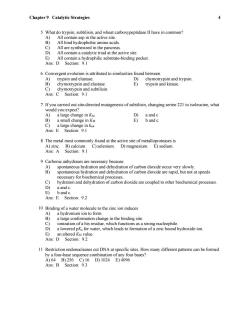
Chapter 9 Catalytic Strategies 4 5 What do trypsin,subtilisin,and wheat carboxypeptidase II have in common? A)All contain asp in the active site. B) All bind hydrophobic amino acids. c) All are synthesized in the pancreas. D All contain a catalytic triad at the active site E) All contain a hydrophilic substrate-binding pocket. Ans:D Section:9.1 6 Convergent evolution is attributed to similarities found between A) trypsin and elastase. D)chymotrypsin and trypsin. B) chymotrypsin and elastase. E) trypsin and kinase. C) chymotrypsin and subtilisin. Ans:C Section:9.1 7 If you carried out site-directed mutagenesis of subtilisin,changing serine 221 to isoleucine,what would you expect? A)a large change in KM D a and c B)a small change in KM E) b and c C)a large change in keat Ans:E Section:9.1 8 The metal most commonly found at the active site of metalloproteases is A)zinc.B)calcium.C)selenium.D)magnesium. E)sodium. Ans:A Section:9.1 9 Carbonic anhydrases are necessary because A) spontaneous hydration and dehydration of carbon dioxide occur very slowly. B) spontaneous hydration and dehydration of carbon dioxide are rapid,but not at speeds necessary for biochemical processes. C) hydration and dehydration of carbon dioxide are coupled to other biochemical processes. D) a and c. E)b and c. Ans:E Section:9.2 10 Binding of a water molecule to the zinc ion induces A)a hydronium ion to form. B)a large conformation change in the binding site. C) ionization of a his residue,which functions as a strong nucleophile. D) a lowered pKa for water,which leads to formation of a zinc bound hydroxide ion. E) an altered KM value. Ans:D Section:9.2 11 Restriction endonucleases cut DNA at specific sites.How many different patterns can be formed by a four-base sequence combination of any four bases? A)64B)256C)16D)1024E)4096 Ans:B Section:9.3
Chapter 9 Catalytic Strategies 4 5 What do trypsin, subtilisin, and wheat carboxypeptidase II have in common? A) All contain asp in the active site. B) All bind hydrophobic amino acids. C) All are synthesized in the pancreas. D) All contain a catalytic triad at the active site. E) All contain a hydrophilic substrate-binding pocket. Ans: D Section: 9.1 6 Convergent evolution is attributed to similarities found between A) trypsin and elastase. D) chymotrypsin and trypsin. B) chymotrypsin and elastase. E) trypsin and kinase. C) chymotrypsin and subtilisin. Ans: C Section: 9.1 7 If you carried out site-directed mutagenesis of subtilisin, changing serine 221 to isoleucine, what would you expect? A) a large change in KM D) a and c B) a small change in KM E) b and c C) a large change in kcat Ans: E Section: 9.1 8 The metal most commonly found at the active site of metalloproteases is A) zinc. B) calcium. C) selenium. D) magnesium. E) sodium. Ans: A Section: 9.1 9 Carbonic anhydrases are necessary because A) spontaneous hydration and dehydration of carbon dioxide occur very slowly. B) spontaneous hydration and dehydration of carbon dioxide are rapid, but not at speeds necessary for biochemical processes. C) hydration and dehydration of carbon dioxide are coupled to other biochemical processes. D) a and c. E) b and c. Ans: E Section: 9.2 10 Binding of a water molecule to the zinc ion induces A) a hydronium ion to form. B) a large conformation change in the binding site. C) ionization of a his residue, which functions as a strong nucleophile. D) a lowered pKa for water, which leads to formation of a zinc bound hydroxide ion. E) an altered KM value. Ans: D Section: 9.2 11 Restriction endonucleases cut DNA at specific sites. How many different patterns can be formed by a four-base sequence combination of any four bases? A) 64 B) 256 C) 16 D) 1024 E) 4096 Ans: B Section: 9.3
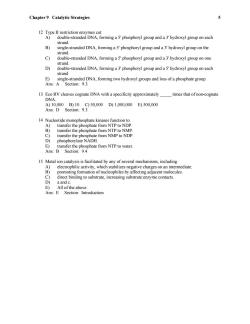
Chapter 9 Catalytic Strategies 5 12 Type II restriction enzymes cut A)double-stranded DNA,forming a 5'phosphoryl group and a 3'hydroxyl group on each strand. B) single-stranded DNA,forming a 5'phosphoryl group and a 3'hydroxyl group on the strand. C) double-stranded DNA,forming a 5'phosphoryl group and a 3'hydroxyl group on one strand. D) double-stranded DNA,forming a 3'phosphoryl group and a 5'hydroxyl group on each strand E)single-stranded DNA,forming two hydroxyl groups and loss of a phosphate group. Ans:A Section:93 13 Eco RV cleaves cognate DNA with a specificity approximately times that of non-cognate DNA. A)10,000B)10C)50,000D)1,000,000E)500,000 Ans:D Section:9.3 14 Nucleotide monophosphate kinases function to A)transfer the phosphate from NTP to NDP. B) transfer the phosphate from NTP to NMP. C) transfer the phosphate from NMP to NDP. D) phosphorylate NADH. E) transfer the phosphate from NTP to water. Ans:B Section:9.4 15 Metal ion catalysis is facilitated by any of several mechanisms,including A) electrophilic activity,which stabilizes negative charges on an intermediate. B) promoting formation of nucleophiles by affecting adjacent molecules. C) direct binding to substrate,increasing substrate:enzyme contacts. D) a and c. E)All of the above. Ans:E Section:Introduction
Chapter 9 Catalytic Strategies 5 12 Type II restriction enzymes cut A) double-stranded DNA, forming a 5' phosphoryl group and a 3' hydroxyl group on each strand. B) single-stranded DNA, forming a 5' phosphoryl group and a 3' hydroxyl group on the strand. C) double-stranded DNA, forming a 5' phosphoryl group and a 3' hydroxyl group on one strand. D) double-stranded DNA, forming a 3' phosphoryl group and a 5' hydroxyl group on each strand E) single-stranded DNA, forming two hydroxyl groups and loss of a phosphate group. Ans: A Section: 9.3 13 Eco RV cleaves cognate DNA with a specificity approximately _____ times that of non-cognate DNA. A) 10,000 B) 10 C) 50,000 D) 1,000,000 E) 500,000 Ans: D Section: 9.3 14 Nucleotide monophosphate kinases function to A) transfer the phosphate from NTP to NDP. B) transfer the phosphate from NTP to NMP. C) transfer the phosphate from NMP to NDP. D) phosphorylate NADH. E) transfer the phosphate from NTP to water. Ans: B Section: 9.4 15 Metal ion catalysis is facilitated by any of several mechanisms, including A) electrophilic activity, which stabilizes negative charges on an intermediate. B) promoting formation of nucleophiles by affecting adjacent molecules. C) direct binding to substrate, increasing substrate:enzyme contacts. D) a and c. E) All of the above. Ans: E Section: Introduction
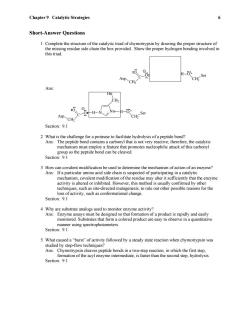
Chapter 9 Catalytic Strategies 6 Short-Answer Questions 1 Complete the structure of the catalytic triad of chymotrypsin by drawing the proper structure of the missing residue side chain the box provided.Show the proper hydrogen bonding involved in this triad. Asp-CH2 CH-Ser Ans: CH Asp-CH2 CH;Ser Section:9.1 2 What is the challenge for a protease to facilitate hydrolysis of a peptide bond? Ans:The peptide bond contains a carbonyl that is not very reactive;therefore,the catalytic mechanism must employ a feature that promotes nucleophilic attack of this carbonyl group so the peptide bond can be cleaved. Section:9.1 3 How can covalent modification be used to determine the mechanism of action of an enzyme? Ans:If a particular amino acid side chain is suspected of participating in a catalytic mechanism,covalent modification of the residue may alter it sufficiently that the enzyme activity is altered or inhibited.However,this method is usually confirmed by other techniques,such as site-directed mutagenesis,to rule out other possible reasons for the loss of activity,such as conformational change. Section:9.1 4 Why are substrate analogs used to monitor enzyme activity? Ans:Enzyme assays must be designed so that formation of a product is rapidly and easily monitored.Substrates that form a colored product are easy to observe in a quantitative manner using spectrophotometers. Section:9.1 5 What caused a"burst"of activity followed by a steady state reaction when chymotrypsin was studied by stop-flow techniques? Ans:Chymotrypsin cleaves peptide bonds in a two-step reaction,in which the first step, formation of the acyl enzyme intermediate,is faster than the second step,hydrolysis Section:9.1
Chapter 9 Catalytic Strategies 6 Short-Answer Questions 1 Complete the structure of the catalytic triad of chymotrypsin by drawing the proper structure of the missing residue side chain the box provided. Show the proper hydrogen bonding involved in this triad. H O CH2 Ser C O O CH2 Asp Ans: H O CH2 H N Ser N CH2 His C O O CH2 Asp Section: 9.1 2 What is the challenge for a protease to facilitate hydrolysis of a peptide bond? Ans: The peptide bond contains a carbonyl that is not very reactive; therefore, the catalytic mechanism must employ a feature that promotes nucleophilic attack of this carbonyl group so the peptide bond can be cleaved. Section: 9.1 3 How can covalent modification be used to determine the mechanism of action of an enzyme? Ans: If a particular amino acid side chain is suspected of participating in a catalytic mechanism, covalent modification of the residue may alter it sufficiently that the enzyme activity is altered or inhibited. However, this method is usually confirmed by other techniques, such as site-directed mutagenesis, to rule out other possible reasons for the loss of activity, such as conformational change. Section: 9.1 4 Why are substrate analogs used to monitor enzyme activity? Ans: Enzyme assays must be designed so that formation of a product is rapidly and easily monitored. Substrates that form a colored product are easy to observe in a quantitative manner using spectrophotometers. Section: 9.1 5 What caused a “burst” of activity followed by a steady state reaction when chymotrypsin was studied by stop-flow techniques? Ans: Chymotrypsin cleaves peptide bonds in a two-step reaction, in which the first step, formation of the acyl enzyme intermediate, is faster than the second step, hydrolysis. Section: 9.1
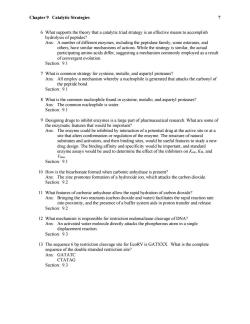
Chapter 9 Catalytic Strategies 7 6 What supports the theory that a catalytic triad strategy is an effective means to accomplish hydrolysis of peptides? Ans:A number of different enzymes,including the peptidase family,some esterases,and others,have similar mechanisms of actions.While the strategy is similar,the actual participating amino acids differ,suggesting a mechanism commonly employed as a result of convergent evolution. Section:9.1 7 What is common strategy for cysteine,metallo,and aspartyl proteases? Ans:All employ a mechanism whereby a nucleophile is generated that attacks the carbonyl of the peptide bond. Section:9.1 8 What is the common nucleophile found in cysteine,metallo,and aspartyl proteases? Ans:The common nucleophile is water. Section:9.1 9 Designing drugs to inhibit enzymes is a large part of pharmaceutical research.What are some of the enzymatic features that would be important? Ans:The enzyme could be inhibited by interaction of a potential drug at the active site or at a site that alters conformation or regulation of the enzyme.The structure of natural substrates and activators,and their binding sites,would be useful features to study a new drug design.The binding affinity and specificity would be important,and standard enzyme assays would be used to determine the effect of the inhibitors on Keat,KM,and Vmax. Section:9.1 10 How is the bicarbonate formed when carbonic anhydrase is present? Ans:The zinc promotes formation of a hydroxide ion,which attacks the carbon dioxide. Section:9.2 11 What features of carbonic anhydrase allow the rapid hydration of carbon dioxide? Ans:Bringing the two reactants(carbon dioxide and water)facilitates the rapid reaction rate into proximity,and the presence of a buffer system aids in proton transfer and release. Section:9.2 12 What mechanism is responsible for restriction endonuclease cleavage of DNA? Ans:An activated water molecule directly attacks the phosphorous atom in a single displacement reaction. Section:9.3 13 The sequence 6 bp restriction cleavage site for EcoRV is GATXXX.What is the complete sequence of the double stranded restriction site? Ans:GATATC CTATAG Section:9.3
Chapter 9 Catalytic Strategies 7 6 What supports the theory that a catalytic triad strategy is an effective means to accomplish hydrolysis of peptides? Ans: A number of different enzymes, including the peptidase family, some esterases, and others, have similar mechanisms of actions. While the strategy is similar, the actual participating amino acids differ, suggesting a mechanism commonly employed as a result of convergent evolution. Section: 9.1 7 What is common strategy for cysteine, metallo, and aspartyl proteases? Ans: All employ a mechanism whereby a nucleophile is generated that attacks the carbonyl of the peptide bond. Section: 9.1 8 What is the common nucleophile found in cysteine, metallo, and aspartyl proteases? Ans: The common nucleophile is water. Section: 9.1 9 Designing drugs to inhibit enzymes is a large part of pharmaceutical research. What are some of the enzymatic features that would be important? Ans: The enzyme could be inhibited by interaction of a potential drug at the active site or at a site that alters conformation or regulation of the enzyme. The structure of natural substrates and activators, and their binding sites, would be useful features to study a new drug design. The binding affinity and specificity would be important, and standard enzyme assays would be used to determine the effect of the inhibitors on Kcat, KM, and Vmax. Section: 9.1 10 How is the bicarbonate formed when carbonic anhydrase is present? Ans: The zinc promotes formation of a hydroxide ion, which attacks the carbon dioxide. Section: 9.2 11 What features of carbonic anhydrase allow the rapid hydration of carbon dioxide? Ans: Bringing the two reactants (carbon dioxide and water) facilitates the rapid reaction rate into proximity, and the presence of a buffer system aids in proton transfer and release. Section: 9.2 12 What mechanism is responsible for restriction endonuclease cleavage of DNA? Ans: An activated water molecule directly attacks the phosphorous atom in a single displacement reaction. Section: 9.3 13 The sequence 6 bp restriction cleavage site for EcoRV is GATXXX. What is the complete sequence of the double stranded restriction site? Ans: GATATC CTATAG Section: 9.3

Chapter 9 Catalytic Strategies 8 14 P-loop domains and mechanisms are common.Why? Ans: These structures are able to undergo large changes in conformation during the binding of NTP and its hydrolysis,thus permitting structural diversity that can account for varied specificity. Section:9.3 15 Why is a metal ion required for the activity of most NTP-dependent enzymes? Ans:The enzyme does not bind the NTP,but binds the complex consisting of the metal ion- nucleotide group. Section:9.4
Chapter 9 Catalytic Strategies 8 14 P-loop domains and mechanisms are common. Why? Ans: These structures are able to undergo large changes in conformation during the binding of NTP and its hydrolysis, thus permitting structural diversity that can account for varied specificity. Section: 9.3 15 Why is a metal ion required for the activity of most NTP-dependent enzymes? Ans: The enzyme does not bind the NTP, but binds the complex consisting of the metal ion- nucleotide group. Section: 9.4
按次数下载不扣除下载券;
注册用户24小时内重复下载只扣除一次;
顺序:VIP每日次数-->可用次数-->下载券;
- 上海交通大学:《生物化学 Biochemistry(B类)》课程教学资源(题库与答案)Chapter 8 Enzymes:Basic Concepts and Kinetics.doc
- 上海交通大学:《生物化学 Biochemistry(B类)》课程教学资源(题库与答案)Chapter 7 Hemoglobin:A Portrait of a Protein in Action.doc
- 上海交通大学:《生物化学 Biochemistry(B类)》课程教学资源(题库与答案)Chapter 6 Exploring Evolution and Bioinformatics.doc
- 上海交通大学:《生物化学 Biochemistry(B类)》课程教学资源(题库与答案)Chapter 5 Exploring Genes and Genomes.doc
- 上海交通大学:《生物化学 Biochemistry(B类)》课程教学资源(题库与答案)Chapter 4 DNA, RNA, and the Flow of Genetic Information.doc
- 上海交通大学:《生物化学 Biochemistry(B类)》课程教学资源(题库与答案)Chapter 3 Exploring Proteins and Proteomes.doc
- 上海交通大学:《生物化学 Biochemistry(B类)》课程教学资源(题库与答案)Chapter 2 Protein Composition and Structure.doc
- 上海交通大学:《生物化学 Biochemistry(B类)》课程教学资源(题库与答案)Chapter 1 Biochemistry:An Evolving Science.doc
- 上海交通大学:《生物化学 Biochemistry(B类)》课程教学资源(题库与答案)Chapter 14 Signal-Transduction Pathways.doc
- 上海交通大学:《生物化学 Biochemistry(B类)》课程教学资源(题库与答案)Chapter 13 Membrane Channels and Pumps.doc
- 上海交通大学:《生物化学 Biochemistry(B类)》课程教学资源(题库与答案)Chapter 12 Lipids and Cell Membranes.doc
- 上海交通大学:《生物化学 Biochemistry(B类)》课程教学资源(题库与答案)Chapter 11 Carbohydrates.doc
- 上海交通大学:《生物化学 Biochemistry(B类)》课程教学资源(题库与答案)Chapter 10 Regulatory Strategies.doc
- 《生物化学 Biochemistry》课程教学资源(课本材料)第09章 催化机制.doc
- 《生物化学 Biochemistry》课程教学资源(课本材料)第08章 酶(基本概念与动力学).doc
- 《生物化学 Biochemistry》课程教学资源(课本材料)第07章 血红蛋白(蛋白质发挥作用的图景).doc
- 《生物化学 Biochemistry》课程教学资源(课本材料)第06章 生物信息学和进化的研究方法.doc
- 《生物化学 Biochemistry》课程教学资源(课本材料)第05章 基因和基因组的研究技术方法.doc
- 《生物化学 Biochemistry》课程教学资源(课本材料)第04章 核酸与遗传信息流(DNA、RNA、和遗传信息流).doc
- 《生物化学 Biochemistry》课程教学资源(课本材料)第03章 蛋白质和蛋白质组学研究技术.doc
- 上海交通大学:《在实验中探究生物技术》课程教学资源(实验)抗生素的发酵生产.pptx
- 上海交通大学:《海洋世界探秘》教学资源(课堂讲稿)海洋第一周.pdf
- 上海交通大学:《海洋世界探秘》教学资源(课堂讲稿)深海冷泉与热液(肖湘).pdf
- 上海交通大学:《海洋世界探秘》教学资源(课堂讲稿)海洋环境与生物.pdf
- 上海交通大学:《海洋世界探秘》教学资源(课堂讲稿)航次的设计与实施(DY115-20航次实施方案).pdf
- 上海交通大学:《海洋世界探秘》教学资源(课堂讲稿)海洋第五周.pdf
- 上海交通大学:《海洋世界探秘》教学资源(课堂讲稿)国家海洋局.pdf
- 上海交通大学:《海洋世界探秘》教学资源(课堂讲稿)生命起源与生物大灭绝.pdf
- 上海交通大学:《海洋世界探秘》教学资源(课堂讲稿)地球科学与地质历史.pdf
- 上海交通大学:《海洋世界探秘》教学资源(课堂讲稿)课程介绍.pdf
- 上海交通大学:《海洋世界探秘》教学资源(课堂讲稿)海洋世界探秘(2.2)航海史.pdf
- 上海交通大学:《海洋世界探秘》教学资源(课堂讲稿)海洋第二周.pdf
- 同济大学:《海洋世界探秘》教学资源(课堂讲稿)海洋环境与生命(Marine Environment and Life).pdf
- 上海交通大学:《海洋世界探秘》教学资源(课堂讲稿)航海史(1/2).pdf
- 上海交通大学:《海洋世界探秘》教学资源(课堂讲稿)航海史(2/2).pdf
- 上海交通大学:《海洋世界探秘》教学资源(课堂讲稿)航次的设计与实施——DY115-20航次实施方案.pdf
- 上海交通大学:《海洋世界探秘》教学资源(课堂讲稿)第一讲 航海史(1/3).pdf
- 上海交通大学:《海洋世界探秘》教学资源(课堂讲稿)第三讲 航海史(3/3).pdf
- 上海交通大学:《海洋世界探秘》教学资源(课堂讲稿)第二讲 航海史(2/3).pdf
- 上海交通大学:《海洋世界探秘》课程教学资源(PPT课件)第一讲 航海史.ppt
